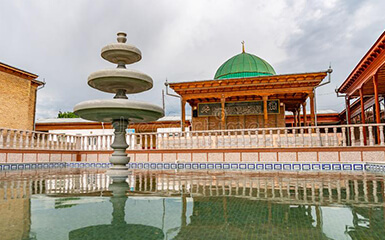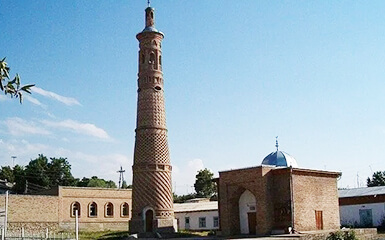Kok Gumbaz
Ajina Teppa
Ancient Panjakent
Anzob Tunnel
Beshkent Qala
Childukhtaron
Khazrati Shokh
Mug Teppa
Gharm Chashma
Hisor Historical
Haji Yaqub mosque
Hazrati-Bobo complex
Lake Iskanderkul
Kalai-Khumb
Karatag
Karon
Khishtin caravanserai
Khorog
Khulbuk
Lake Karakul
Abdullatif Sultan
Madrasai Kuhna
Abu Abdullah Rudaki
Khoja Mashhad
Khudoyor Valami
Makhmudi Azam
Mir Sayyid Ali Hamadani
Muhammed Bashoro
Sheikh Muslihiddin
Nurek Mountain Lake
Pamir
Sarazm
Sari-Khosor
Seven Lakes
Shirkent
Chiluchorchashma
Takht-i Sangin
Complex Khazrati Shokh

Mausoleum of Khazrati Shokh (18th century). Absolutely every inhabitant of Istaravshan knows who is buried in the mausoleum of Khazrati Shokh - this sacred place is the grave of Saint Khazrati Shokh - the brother of Kusam ibn Abbas, a cousin of the Prophet Muhammad, buried in the 11th century in the Samarkand ensemble of Shahi Zinda. This is the oral tradition of these places. The mausoleum itself, which is one of the most ancient sights of Tajikistan, is part of the historical and architectural complex "Khazrati Shokh", located in the old part of the city of Istaravshan. The complex consists of three religious buildings: the Khazrati Shokh mausoleum, the Khudoyor Valami mausoleum and the Khazrati Shokh mosque (also known as Namazgokh), dating back to the 19th century. All three buildings are located in a semicircle. Each of them was built at a different time and has its own history of creation and purpose. In the past, the complex also included a city cemetery and a madrasah.
Today, the Khazrati Shokh mausoleum is a modest two-domed brick structure with a tomb (gurkhan) and a prayer house (ziyoratkhon), which has been repeatedly restored. In front of the building of the mausoleum there is a spring, the water of which is considered sacred and healing. According to legend, the spring was formed after the Caliph Ali lowered his staff into the alpine lake Oykul. The staff floated up at the feet of Hazratishokh, buried in Ura-Tyube. At this place, a spring arose. It was from this spring, according to scientists, that the history of the mausoleum began. Near the spring, as the personification of the source of life among Muslims, the burial of a revered religious figure appeared. Later, a mausoleum was built over his grave.
The complex dates back to the 18th century, although historically it arose much earlier - in the 10-11th centuries.
Hazrati Shokh Mosque (Namazgokh). According to legend, a wealthy man from the Tal quarter, Mirzo Kobil, in 1891-1892, built the mosque. The aivan of the mosque was built later by aksakal Salimbay. With two rows of carved columns, it towered over a transparent house with spring water. There was a cold bath (takhorathona) with several rooms near the spring. The mosque was renovated in 1913. It is located on the territory of Guzari Namozgokh, which in the period from the late 18th to the early 20th century was considered the cultural, religious, commercial and social centre of Istaravshan.
The Hazrati Shoh cathedral mosque served as a place for Friday prayers of city residents during major Muslim holidays and on weekdays.

